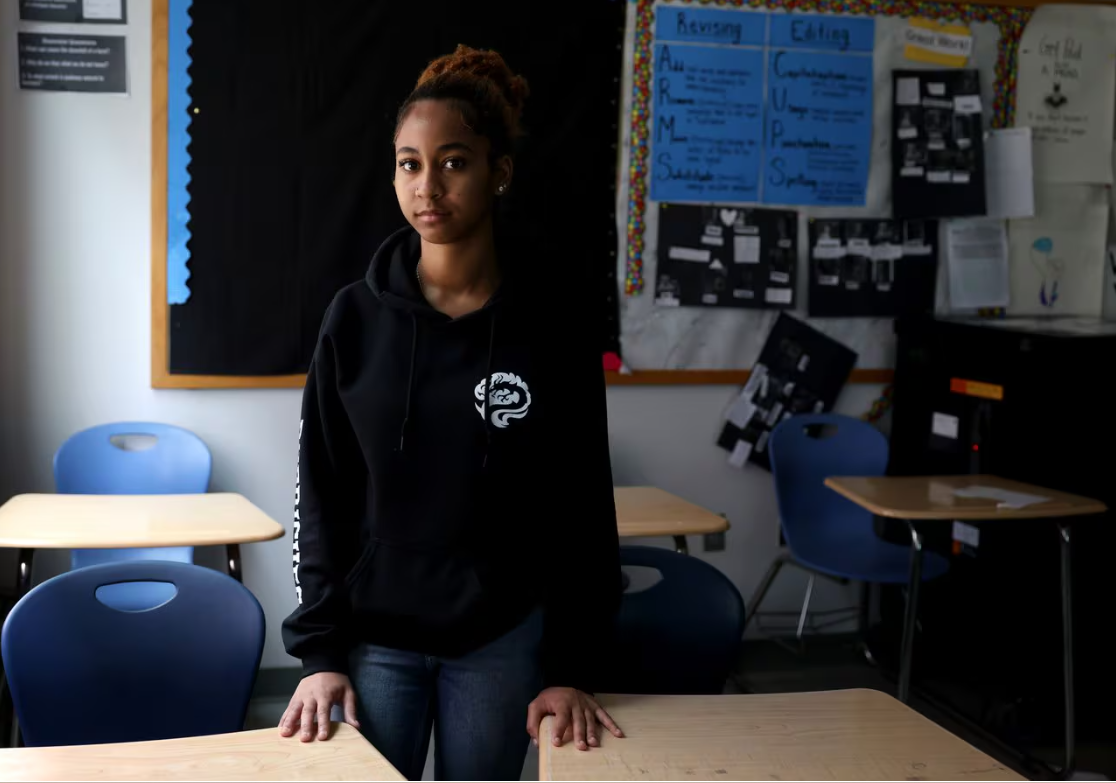FAFSA 的延迟和平权行动的结束相冲突,导致了一个混乱的大学招生季

【中美创新时报2024年4月1日波士顿讯】(记者温友平编译)艾琳·罗德里格斯 (Ailine Rodrigues) 被她申请的所有 11 所大学录取。作为一名有抱负的第一代学生,由于联邦政府财政援助计划的延误,她仍然不知道自己是否能负担得起自己的首选学校或其他四年制大学的费用。《波士顿环球报》记者希拉里·伯恩斯(Hilary Burns) 对此作了下述详细报道。
“这真的令人沮丧,”罗德里格斯说。 “我妈妈一直在问我学校是否说过我们要支付多少钱,而我不知道如何回答她的问题。 所以我去找我的大学辅导员,问他们,但他们也不知道。”
经济援助计划的长期僵局正在扰乱今年春天的大学录取季,正当大学和申请者了解到美国最高法院去年禁止平权行动——以及学校为缓解这一禁令所做的努力——将如何影响校园的多样性时。通常在学生进入大学之前大约一个月,联邦政府还没有告诉许多家庭他们将获得多少援助。
“这是一场灾难,”波士顿基金会高等教育成功之路项目官员杰德·弗兰科(Jade Franco)说,该基金会帮助大波士顿地区的低收入学生为接受高等教育和职业做好准备。“这些学生的背景需要克服更多障碍——这些学生确实很挣扎,对今年的经济援助过程感到非常沮丧和崩溃。”
要申请联邦援助和奖学金,学生必须通过联邦学生援助免费申请(FAFSA)向联邦政府提供广泛的财务信息。许多大学利用这些数据作为向学生提供经济援助计划的基础,通常是在三月下旬——通常要早得多。通常要求学生在 5 月 1 日之前缴纳押金以确保名额。
然而,今年,错误、延误和官僚机构功能失调扰乱了本应简化的 FAFSA 表格的推出。例如,学生在提交父母的社会安全号码时遇到困难,尤其是在父母一方或双方都没有证件的情况下,并且需要等待很长时间才能获得帮助。根据国家大学成就网络 (National College Attainment Network) 的 FAFSA Tracker 数据,截至 3 月 15 日,今年完成联邦经济援助表的学生减少了约 30%。
经济援助无疑将在学生的决策中占据重要地位。根据美国教育部的数据,2020 年,约 72% 的本科生获得了某种类型的经济援助,其中约 81% 的黑人学生、72% 的拉丁裔学生、70% 的白人学生和 66% 的亚裔学生 。
作为一种解决方法,一些学校正忙着整理援助方案,收集自己的财务信息,或者推迟学生提交押金的最后期限。
高等教育观察人士担心,失败的推出意味着中低收入学生将无法权衡多种录取通知书并做出明智的决定。弗兰科说,尽管学生可以要求延期缴纳押金,但来自边缘化背景的学生不太可能“寻求帮助并举手请求”。
“这增加了更多的步骤和繁文缛节,”她说。
马萨诸塞州学校辅导员协会执行董事鲍勃·巴德韦尔(Bob Bardwell)表示,他担心一些学生会选择工作或间隔年,或者就读社区大学而不是进入四年制学校。
“FAFSA 完全是一场噩梦,”巴德韦尔说。 “这些家庭可能认为高等教育不值得。这是一种耻辱。政府应该帮助他们。”
美国教育部发言人表示,该部仍然“致力于帮助学生和家庭完成这一过程,并支持大学尽快提供援助。”
该发言人表示:“我们现已处理了超过 600 万份 FAFSA 表格,并且正在恢复正常处理时间表,这意味着学院和机构将在提交后一到三天内收到学生记录。” “该部门继续鼓励学校、州和奖学金组织为学生提供灵活性和尽可能多的时间来做出重要的入学决定。”
进入今年的招生季,一些大学领导担心最高法院的平权行动决定会导致申请精英大学的有色人种学生减少。例如,在加利福尼亚州,1996 年禁止平权行动后,黑人和西班牙裔高中毕业生申请顶尖公立大学的人数下降。
然而,今年招生周期的初步数据表明,这种情况并未发生:使用 Common App 申请四年制大学的黑人、拉丁裔、美洲原住民和太平洋岛民的数量比一年前增加了 10%,并且 Common App 最近发布的数据显示,第一代申请者数量增长了 4%。包括哈佛大学和布朗大学在内的几所大学去年 12 月报告说,他们在早期招生中录取了更高比例的第一代学生。
这可能部分是因为许多大学去年采取了措施鼓励黑人和西班牙裔学生申请,包括派出代表与更多有色人种学生比例较高的高中的学生进行交谈。
高等教育咨询公司 Kennedy & Company 的副校长肯德拉·格林尼奇 (Kendra Grinnage) 表示:“我担任了六年的高中辅导员,当你有一名[大学代表]来到学校与学生交谈时,这真是一件大事。” 。
大学还与帮助低收入高中生的社区组织建立了更牢固的合作伙伴关系,并重新培训招生官员,以忽略申请人的种族。
高等法院的裁决并没有结束招生政策,大学会考虑申请人的生活经历和他们所克服的挑战等因素。许多大学增加了补充论文问题,让申请者有机会谈论文化、种族、性别和社区等因素如何影响他们的身份、世界观和抱负。
例如,马萨诸塞大学阿默斯特分校现在要求学生反思定义或塑造他们世界的社区或团体,以及作为该社区的产物将如何丰富校园。
麻省大学阿默斯特分校负责招生管理的副教务长吉姆·罗奇(Jim Roche)表示:“掌握更多一点信息,将事情放在背景中就非常有帮助。”
然而,与富裕家庭和学生合作的 Ivy Link 创始人亚当·阮 (Adam Nguyen) 表示,这些变化使得原本就已经不透明且会带来压力的申请过程变得更加令一些学生感到困惑,他们质疑是否应该讨论种族问题。提高他们被选入顶尖大学的机会。
“如果我不属于以前的受保护类别,我应该提出种族问题吗?” 阮说。 “这正是学生们想知道的。我克服了哪些挑战?”
一些大学今年招收了更多的学生,这“让他们有更好的机会进入多元化的班级,”鲁法洛·诺埃尔·莱维茨(Ruffalo Noel Levitz)驻爱荷华州的招生顾问、为大学提供咨询的韦斯·巴特菲尔德(Wes Butterfield)说。 “你是根据数量来做的。”
麻州大学阿默斯特分校的申请量连续第二年超过 50,000 人,录取学生比一年前增加 1.5%。 麻省大学今年招收了 29,567 名学生;一年级有5,275名学生。
与此同时,代表性不足群体的学生申请量增长了 11%,这些群体的录取人数增加了 7%。非裔美国人、拉丁美洲人、美洲原住民和阿拉斯加原住民学生占麻省大学阿默斯特分校本科生人数的 17%。
罗德里格斯是海德公园环太平洋特许学校学院的一名高年级学生,当她还是个孩子的时候,她和家人从佛得角搬到了马萨诸塞州。她被波士顿的东北大学、麻省大学阿默斯特分校和新罕布什尔州戈夫斯敦的圣安瑟姆学院录取。她的首选是东北大学,因为该校提供强大的实习和带薪实习项目。
根据教育部大学记分卡的数据,东北大学本学年在财政援助前的总标价为 86,821 美元,而学生每年支付的平均入学费用为 34,255 美元。
如果她的经济援助计划在押金到期前没有到达,她的母亲敦促她申请社区大学。
“如果 FAFSA 不给我们任何钱,那可能是我唯一的选择,因为我们付不起那么多钱,”罗德里格斯说。
题图:艾琳·罗德里格斯(Ailine Rodrigues)在环太平洋特许学校学院的教室里摆姿势拍照。 FAFSA 的延误正在影响罗德里格斯的大学决定。JESSICA RINALDI/GLOBE STAFF
附原英文报道:
FAFSA delays and end of affirmative action are colliding for a chaotic college admissions season
By Hilary Burns Globe Staff,Updated March 30, 2024
Ailine Rodrigues was accepted to all 11 colleges she applied to. An aspiring first-generation student, she still doesn’t know if she can afford her top choice or other four-year institutions because of delays with the federal government’s financial aid program.
“It’s really frustrating,” Rodrigues said. “My mom all the time [is] asking me if the college has said anything about how much we’re going to pay, and I don’t know how to answer her questions. So I come to my college counselor, and I ask them, but they don’t know either.”
The lengthy logjam in the financial aid program is disrupting the college acceptance season this spring just as colleges and applicants learn how the US Supreme Court’s ban on affirmative action last year — and the schools’ efforts to mitigate it — will affect diversity on campus. About one month before students are typically expected to secure their spots at universities, the federal government has not told many families how much aid they will get.
“This has been a disaster,” said Jade Franco, program officer for the Boston Foundation’s Pathways to Postsecondary Success, which helps prepare low-income students in the Greater Boston region for higher education and careers. “The students who are coming from backgrounds that have more obstacles to overcome — those students have really struggled, and feel very frustrated and broken by this year’s financial aid process.”
To apply for federal aid and scholarships, students have to provide extensive financial information to the federal government through the Free Application for Federal Student Aid, or FAFSA. Many colleges use that data as the basis for the financial aid packages they offer to students, usually by late March — often much earlier. Students are normally required to send deposits to secure their spots by May 1.
This year, however, errors, delays, and bureaucratic dysfunction disrupted the rollout of what was supposed to be a simplified FAFSA form. For example, students had trouble submitting their parents’ Social Security numbers, especially if one or both parents were undocumented, and faced long wait times for assistance. About 30 percent fewer students completed the federal financial aid form this year as of March 15, according to the National College Attainment Network’s FAFSA Tracker.
Financial aid will undoubtedly loom large in students’ decision-making. In 2020, about 72 percent of all undergraduates received some type of financial aid, according to the US Department of Education, including about 81 percent of Black students, 72 percent of Latino students, 70 percent of white students, and 66 percent of Asian students.
As a workaround, some schools are rushing to put together aid offers, collecting their own financial information, or are pushing back deadlines for students to submit deposits.
Higher education watchers worry the botched rollout means low- and middle-income students will not be able to weigh multiple offers and make informed decisions. And although students can request extensions for their deposits, students from marginalized backgrounds are less likely “to ask for help and raise their hand to ask,” Franco said.
“It’s adding more steps and red tape,” she said.
Bob Bardwell, executive director of the Massachusetts School Counselors Association, said he is concerned some students will instead take a job or a gap year, or attend a community college rather than enroll at a four-year school.
“FAFSA is a complete nightmare,” Bardwell said. “These are families who may decide higher ed is not worth it. That is a shame. The government is supposed to be helping them.”
A spokesperson for the US Department of Education said it remains “focused on helping students and families through this process and supporting colleges produce aid offers as quickly as possible.”
“We have now processed more than 6 million FAFSA forms and [are] now returning to normal processing timelines, which means colleges and institutions will receive student records within one to three days after submission,” the spokesperson said. “The department continues to encourage schools, states, and scholarship organizations to provide flexibility and as much time as possible for students to make important enrollment decisions.”
Heading into this year’s admissions season, some college leaders feared the Supreme Court’s affirmative action decision would cause fewer students of color to even apply to elite colleges. In California, for example, applications to top public universities from Black and Hispanic high school graduates fell after the state banned affirmative action in 1996.
Preliminary data from this year’s admissions cycle, however, suggest that hasn’t happened: The number of Black, Latino, Native American, and Pacific Islander applicants to four-year colleges using the Common App was up 10 percent from a year earlier, and the number of first-generation applicants grew 4 percent, according to data published recently by the Common App. And several colleges, including Harvard University and Brown University, reported in December they accepted higher percentages of first-generation students in their early admissions rounds.
That may be in part because many colleges took steps last year to encourage Black and Hispanic students to apply, including sending representatives to talk with students at more high schools with high proportions of students of color.
“I was a high school counselor for six years, and that was a really big thing when you have a [college representative] come to school and talk to students,” said Kendra Grinnage, an associate principal with higher education consulting firm Kennedy & Company.
Colleges also developed stronger partnerships with community organizations that work with low-income high school students and retrained admission officers to ignore applicants’ race.
The high court’s decision did not end admissions policies where colleges consider factors such as applicants’ life experiences and the challenges they’ve overcome. Many colleges added supplemental essay questions to give applicants the opportunity to talk about how factors such as culture, ethnicity, gender, and community have influenced their identities, world views, and ambitions.
The University of Massachusetts Amherst, for example, now asks students to reflect on a community or group that has defined or shaped their world, and how being a product of that community would enrich the campus.
“Having just a little bit more information that puts things in context was very helpful,” said Jim Roche, vice provost for enrollment management at UMass Amherst.
However, these changes made the application process, already an opaque and stress-inducing experience, more confusing for some students, who questioned whether they should discuss race or not, said Adam Nguyen, founder of Ivy Link, which works with wealthy families and students to improve their chances of being selected to top colleges.
“Should I bring up race if I’m not in a previously protected class?” Nguyen said. “That is what students were wondering about. What challenges did I overcome?”
Some colleges admitted more students this year, which “gives them a better chance to end up with a diverse class,” said Wes Butterfield, an Iowa-based enrollment consultant with Ruffalo Noel Levitz who advises colleges. “You’re doing it based on volume.”
Applications to UMass Amherst surpassed 50,000 for the second year in a row, with accepted students up 1.5 percent from a year ago. UMass accepted 29,567 students this year; the first-year class is 5,275 students.
Applications from students in underrepresented groups, meanwhile, grew 11 percent, and admissions from those groups increased by 7 percent. African American, Latino, Native American, and Alaskan Native students account for 17 percent of the undergraduate population at UMass Amherst.
Rodrigues, a senior at the Academy of the Pacific Rim Charter School in Hyde Park, moved with her family to Massachusetts from Cape Verde when she was a toddler. She was accepted to Northeastern University in Boston, UMass Amherst, and Saint Anselm College in Goffstown, N.H. Her top choice is Northeastern because of the school’s robust internship and co-op programs.
Northeastern’s total sticker price before financial aid for the current academic year is $86,821, while the average annual cost students pay to attend the school is $34,255, according to the Department of Education’s College Scorecard.
Her mother urged her to apply to community college if her financial aid packages don’t arrive before deposits are due.
“If FAFSA doesn’t give us any money, that would probably be my only choice, because we can’t pay that much,” Rodrigues said.

